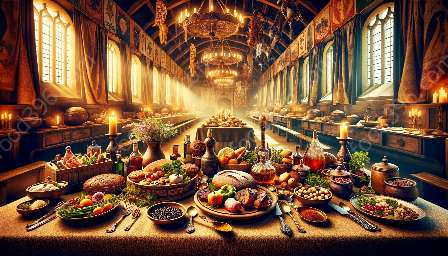Medieval food and dining were deeply intertwined with the social and cultural fabric of the time. Understanding the customs, etiquette, and traditions associated with medieval cuisine provides valuable insights into the heritage of cuisine history.
The medieval period, spanning from the 5th to the 15th century, was characterized by a hierarchical social structure that influenced the way people dined and the types of food they consumed. The societal norms and values of the time greatly impacted the culinary practices, leading to a rich tapestry of flavors, customs, and traditions.
The Social Hierarchy and Dining
One of the defining features of medieval food and dining was the strict adherence to social hierarchy. The nobility, clergy, and commoners each had distinct dining customs and etiquette that reflected their social standing.
Nobility: The nobility enjoyed elaborate feasts and banquets, where food was not only sustenance but a symbol of wealth and prestige. Dining was a social event, and lavish displays of food were used to flaunt power and opulence.
Clergy: The clergy also had specific dietary customs, often influenced by religious practices. Monastic dining, for example, revolved around simple, communal meals with an emphasis on moderation and frugality.
Commoners: Commoners, on the other hand, had limited access to luxurious ingredients and often relied on simple, locally sourced foods. Their meals were more utilitarian, focused on sustenance rather than extravagance.
Feasts and Festivities
Medieval society was punctuated by various feasts and festivities, each with its own culinary traditions and significance. Feasts were not merely opportunities to indulge in food and drink; they were integral to social bonding, communal celebration, and religious observance.
Seasonal Festivals: The medieval calendar was marked by seasonal festivals, such as harvest festivals and religious holidays, each with its own set of traditional dishes and customs.
Royal Banquets: The nobility hosted extravagant banquets to mark special occasions, such as weddings, coronations, and diplomatic events. These opulent feasts were a display of power and magnificence, with carefully choreographed dining rituals and entertainment.
Communal Meals: Commoners often partook in communal meals, such as village gatherings and local fairs. These occasions provided an opportunity for shared experiences and camaraderie, often accompanied by rustic, hearty fare.
Culinary Influence and Exchange
The medieval period was characterized by a rich tapestry of culinary influence and exchange. The influx of new ingredients, cooking techniques, and culinary traditions from distant lands brought about a transformation in the medieval culinary landscape.
Arab and Byzantine Influence: The Crusades facilitated cultural exchange, introducing spices, fruits, and culinary techniques from the Arab and Byzantine worlds into medieval European cuisine. The incorporation of exotic flavors and ingredients added depth and complexity to the culinary offerings of the time.
Trade Routes and Culinary Exchange: The flourishing trade routes of the medieval period facilitated the exchange of foodstuffs and culinary knowledge across continents. The introduction of staples such as spices, sugar, and rice transformed the culinary repertoire of medieval kitchens.
Regional Variation: While there were overarching culinary trends in medieval Europe, regional variation played a significant role in shaping local cuisines. Each region had its own unique culinary identity, influenced by factors such as geography, climate, and cultural exchanges.
Etiquette and Table Manners
Medieval dining was governed by a strict code of etiquette and table manners, each reflecting the social mores and values of the time. Table manners, seating arrangements, and dining rituals were all imbued with symbolic meaning and significance.
Seating Hierarchy: Seating arrangements at medieval banquets were meticulously structured to reflect social hierarchy, with the most esteemed guests seated at the high table. This practice reinforced the existing social order and power dynamics.
Utensils and Dining Etiquette: The use of utensils and dining etiquette varied across social classes. While the nobility employed elaborate dining implements and observed intricate dining rituals, commoners often made do with simpler utensils and informal dining customs.
Feasting and Merriment: Feasts and banquets were occasions for revelry and merriment, with entertainment, music, and jesters adding to the festive atmosphere. These events were not merely about food but were immersive sensory experiences that celebrated the art of dining.
Legacy in Cuisine History
The social and cultural aspects of medieval food and dining have left an indelible mark on cuisine history. The customs, etiquette, and culinary traditions of the medieval period continue to influence contemporary dining practices and culinary heritage.
Culinary Heritage: Many traditional dishes and culinary techniques that originated in medieval times have persevered, forming the bedrock of modern European cuisine. Regional specialties and time-honored recipes are a testament to the enduring legacy of medieval culinary practices.
Social Dining Customs: Elements of medieval dining customs, such as communal feasting and the symbolism of food, have found resonance in modern dining experiences. Concepts of hospitality, generosity, and conviviality continue to underpin the social fabric of dining.
Historical Reenactments and Festivals: The reenactment of medieval banquets and culinary festivals allows contemporary audiences to immerse themselves in the culinary heritage of the past, gaining a deeper appreciation for the social and cultural significance of medieval food and dining.
The social and cultural aspects of medieval food and dining form a captivating tapestry of traditions, rituals, and culinary exchange, offering a window into the rich heritage of cuisine history. Exploring the customs and etiquette associated with medieval cuisine provides a deeper understanding of the social dynamics and culinary evolution of the time, enriching our appreciation of the enduring legacy of medieval gastronomy.

